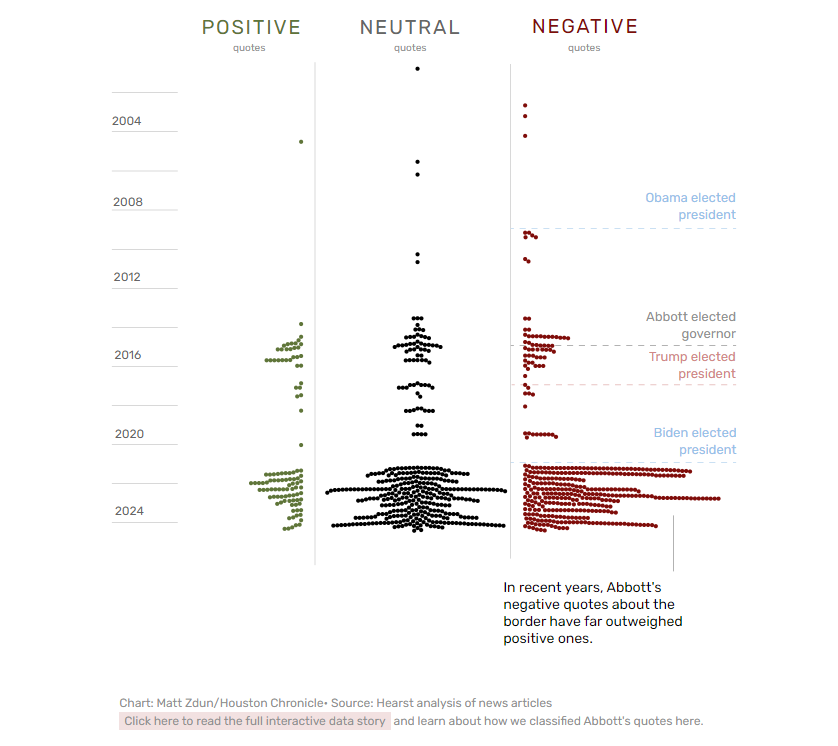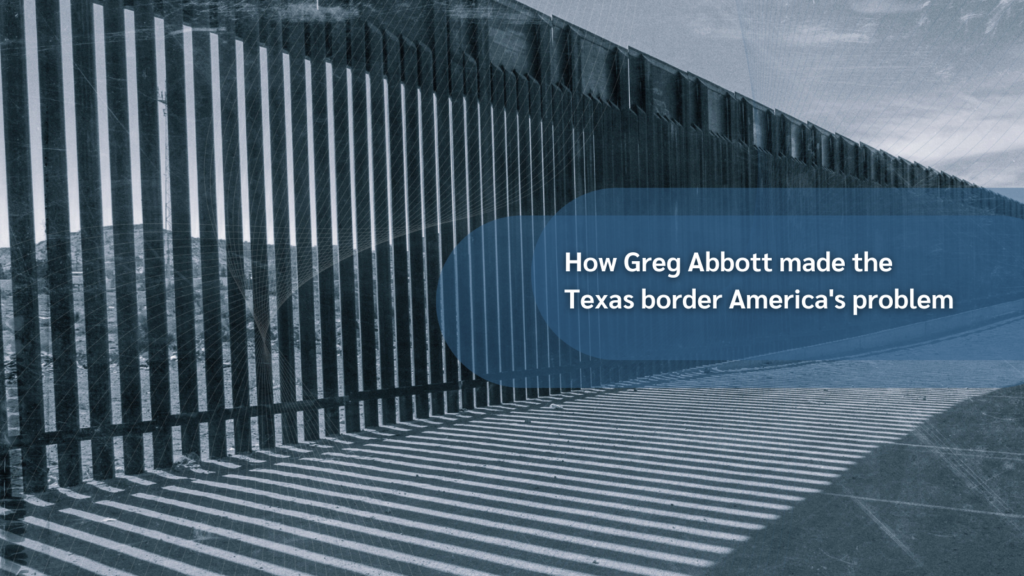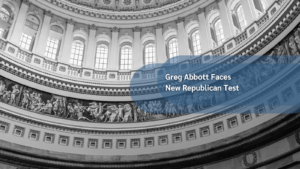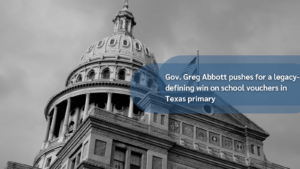Greg Abbott was back at the border, describing a state under siege.
Children were afraid to play outside. Ranches were being destroyed. Neighborhoods were overrun by drugs, human smuggling and gun-wielding immigrants.
“And the federal government and the Biden administration does not care about it,” the governor said in June 2021.
For three years now, Abbott has delivered a near daily version of the same indictment, hounding President Joe Biden on immigration in press conferences, on social media, in Fox News appearances and trips to South Texas.
As Donald Trump claims the GOP’s nomination this week in Milwaukee, no Republican has done more than Abbott to keep the former president’s signature issue top of mind for voters across the nation. And in the process, he’s tethered himself to the party’s ascendant right wing.
TIMELINE: The evolution of Greg Abbott’s stance on immigration
“He is effectively acting as the Trump administration in exile,” said Muzaffar Chishti, a senior fellow at the non-partisan Migration Policy Institute.
Immigration is a familiar target for Republicans, especially when a Democrat is in the White House. But Abbott has taken it to new levels, leveraging billions of state dollars on a militarized crackdown, arresting and detaining thousands of migrants, busing many more to Democratic-led cities and attempting to seize deportation duties from the federal government.
The barrage has catapulted the third-term governor, 66, into the national spotlight at a moment when Republicans are feeling hopeful about their chance to retake the presidency in November — and eying who could one day pick up the torch after Trump.
Abbott’s appeal will be tested this week like never before as he seeks to translate his policy victories at the border to a broader Republican audience, who will be focused on immigration Tuesday with the RNC’s planned “Make America Safe Again” theme. The governor, who has a sought-after speaking slot at the convention but was still deciding on Monday whether to attend amid Hurricane Beryl recovery efforts, is not known for being a charismatic speaker and has not always been warmly welcomed by ultra-conservative voters.
“In politics now, especially where the Republican Party is, you only get one bite at the apple, and he has to make it count,” said Brandon Rottinghaus, a political scientist at the University of Houston. “He is a national figure in many regards. But it hasn’t translated to real political power, at least outside the state lines.”
The governor has long shot down questions about seeking higher office. But he has laid down a road map for a national bid, showing it’s hard to lose on immigration enforcement in the current political climate.
Just a few years ago, as Trump left office, voters were divided on finishing a border wall and staunchly opposed to his push to separate migrant families. Now, even Democrats are pushing restrictions to the asylum system Biden campaigned on rebuilding in 2020, and polling shows a majority of voters are open to much more radical ideas, including mass deportations.
The sentiment is changing even as immigration experts say Abbott’s crackdown has done little to deter migrants.
“Abbott has made people think about the border crisis not as a crisis at the border, but more a crisis in the interior of the country,” Chishti said.
‘Keep pushing the line further’
In Texas, Abbott has benefited from Republican voters’ near-endless appetite for border security. State GOP voters, primarily older and white, consistently say the border is the most important issue facing the state, that the country allows too many people to immigrate legally and that more should be done to secure the border — regardless of what the crossing trends, state spending or current policies may be.
“When all of your voters are telling you what the No. 1 issue is, poll after poll, year after year — and there’s almost nothing you can do that’s going to cross any sort of red line, at least with your voters — then the only thing to do is essentially keep pushing the line further and further,” Blank said. “That’s what we’ve seen here.”
Abbott began calling for troops at the border as far back as his first run for attorney general, more than two decades ago — adopting a popular GOP proposal in the wake of 9/11. But the border crackdown now underway is likely beyond anything the younger, more moderate state supreme court judge foresaw.
In 2002, Abbott balked at criticism of his calls to send soldiers to South Texas as an attempt to “militarize” the border. Now he’s boasting of a permanent armed presence, with Texas opening a National Guard base in Eagle Pass, where miles of razor wire lining the Rio Grande already give it the feel of a war zone.
The biggest shift, however, has been his declaration of a migrant “invasion.” In his first run for governor, Abbott’s campaign reportedly warned other Republicans on the ticket against using such inflammatory language, fearing it could turn off Latino voters, an increasingly powerful voter block in Texas politics Abbott was bent on winning over. His campaign launched a Spanish-language website and ads and regularly emphasized his personal connection to the community by noting his wife, Cecilia, would be the first Hispanic first lady of Texas.
At the state GOP convention, he addressed the crowd in Spanish.
“Juntos somos una familia,” Abbott told the crowd. “Together, we are one family.”
As Abbott moved into the governor’s mansion at the beginning of 2015, he faced a party transformed after years of Tea Party activism. Business-minded immigration policies once championed by the GOP, such as work permits and tuition for undocumented students, were out of favor, seen as amnesty by immigration hardliners.
INTERACTIVE: We asked A.I. to analyze Abbott’s rhetoric about the Texas border. He’s changed his tone dramatically.
Texas was also becoming an epicenter of immigration after years of California and Arizona bearing the brunt of it. The Rio Grande Valley began to emerge as a top corridor as smugglers identified train routes there that could more easily carry asylum-seeking families into the country.
Abbott ratcheted up restrictions, signing a “show-me-your papers” law in 2017 that critics warned would lead to racial profiling. He also made Texas the first state to refuse to resettle refugees and banned so-called sanctuary cities, where law enforcement is discouraged from disclosing a person’s immigration status. After Biden took office, the governor started a crowd fundraiser to build a wall along the U.S.-Mexico border.
Yet Abbott was under pressure to do more as he approached the end of his second term. When challenged in 2021 by far-right gubernatorial candidates who called his approach to the border weak, he declared on Tucker Carlson’s Fox News program that he had assigned thousands of National Guard troops to South Texas who were laying down razor wire at that very moment.
“Joe Biden believes in open border policies,” Abbott said on the segment. “That leaves it to the states now to step up and do everything we can to hold onto the United States of America until Republicans can regain control of Congress and the presidency.”
Even in the face of a rare political misstep, Abbott has been undeterred. After he levied new safety inspections on trucks coming into Texas from Mexico, cross-border trade ground to a near-halt with vehicles backed up for hours waiting to get into the state.
He quickly eased the inspections amid bipartisan backlash and after getting agreements from all four of the Mexican governors whose states share borders with Texas to do more immigration patrols south of the Rio Grande. A week later, Mexican President Andrés Manuel López Obrador called the program despicable and Abbott threatened to reinstate the inspections.
The governor’s office declined to make him available for this story. Those who have worked with Abbott say it’s not his views that have shifted, but the reality on the border. Crossings reached historic levels during Biden’s time in the White House, centered more than ever on Texas border towns strained by the unprecedented migration.
“I think the evolution there is natural in the respect that any observer cannot look at that situation and say we don’t have a problem,” said John Colyandro, a lobbyist and former policy director for Abbott.
Abbott has always had a knack for reading the Republican tea leaves. While he may not deliver the folksy, charismatic speeches of his predecessor Rick Perry, he has shown repeatedly he knows how to stay on top of what voters want. Abbott has never come close to losing an election.
“Abbott’s a quick study,” said Cal Jillson, a political scientist at Southern Methodist University.
Over time, Jillson said, Abbott has evolved from a steady, studious policymaker to more of a “political gunslinger.”
His public rhetoric about the border has grown increasingly dark since 2020, according to a Hearst Newspapers analysis, which tracked and measured his documented remarks over the past two decades. And he has hammered it more than ever since Biden took office, in more and more negative terms.
Abbott has spoken about the border in increasingly negative terms over time

Critics have warned that politicians’ inflammatory rhetoric has dangerous consequences, and point to the mass shooting in El Paso 2019, when a gunman killed 23 people after allegedly posting a hate-filled screed railing against a “Hispanic invasion of Texas.”
Abbott began calling migration at the border an invasion in 2022, after fending off two right-wing primary challengers and resisting calls from former Trump officials to declare one. The governor argued the Constitution allows states to defend themselves in the face of an invasion, and declared the massive uptick in crossings amounted to just that.
In January of this year, Abbott drew headlines when he said Texas was doing everything to stop migrants short of shooting them. “The only thing that we’re not doing is we’re not shooting people who come across the border because of course the Biden administration would charge us with murder,” he said.
A watershed moment
After Trump’s defeat in 2020, Abbott turned the state into a testing ground for border security policies, including trying out some ideas the former president’s administration explored, but had yet to put in place.
Abbott “picked up the ball,” Trump said during a trip earlier this year to Eagle Pass, where he joined the governor on a tour of the public park that state soldiers seized and transformed into ground zero for Operation Lone Star.
Nearby was a string of buoys the governor deployed into the Rio Grande last year, acting on an idea initially cooked up by Trump administration officials, who tested the floating barrier but never deployed it.
Busing migrants to Democratic-run cities was also pitched by Trump.
Thomas Homan, who served under Trump as acting director of U.S. Immigration and Customs Enforcement, said the former president never acted on it, in part because crossings began to decline.
Abbott’s office wouldn’t say whether they got the idea from former Trump officials. Homan believes his office came up with it independently.
Regardless, Homan said he believes Abbott has proven over the last four years that Trump’s policies work. Since 2022, Abbott has shuttled more than 119,400 migrants to New York, Los Angeles, Chicago and other major cities at a cost of more than $148 million to Texas taxpayers, according to the Texas Tribune.
“Look what it’s done — it made immigration the top issue in the country,” Homan, who is now a vocal critic of the Biden administration and a fellow at the conservative Heritage Foundation, said of the busing. “Immigration was lagging at the time, it was on the third page. He put it back on the front page.”
The busing appeared to be a watershed moment for Abbott, demonstrating he could weaponize the border against Democrats even outside of Texas or the White House — and creating a national profile for the governor in the process.
At its peak late last year, the program overwhelmed Democratic officials in New York and other cities, who in turn pressured Biden publicly to do more to curb crossings. The president, who campaigned on rebuilding the asylum system, began pushing for a bipartisan agreement in Congress to limit the claims. When that failed to pass, Biden instituted new restrictions on his own, signing an executive order last month that shut off asylum processing when more than 2,500 migrants illegally cross into the U.S. in a single day.
“Abbott saw he could take a fight to Democratic governors and mayors in the north and really turn them into advocates for border security in ways they had never really been before,” Jillson said.
INSIGHT FROM JEREMY WALLACE: If Greg Abbott is going to run for president in 2028, it starts now. What’s at stake at the RNC
Abbott and his defenders have credited the border operation for a drop in crossings since January.
Experts are less sure, pointing to a host of other potential factors, including smugglers shifting their routes.
Even some fans of Operation Lone Star have stopped short of giving Abbott credit for the decline, which they say is more likely due to Mexican enforcement that the nation ratcheted up under pressure from Biden administration officials, who made a trip to Mexico City amid a major surge in crossings last year.
“The Abbott administration is taking a lot of credit for that with all their fortifications. But the truth is that they have a lot of help from the Mexican government in Mexico City. That’s who’s really doing it,” Todd Bensman, a fellow at the right-wing Center for Immigration Studies, told a crowd of GOP faithful at the state Republican Party convention this summer.
Critics say Abbott’s miles of razor wire have only served to further endanger migrants who are going to attempt river crossings regardless. Arresting and detaining thousands of migrants for trespassing on private land has had little impact on their ability to later claim asylum and remain in the country while their cases are processed, attorneys representing them said. But the state has spent hundreds of millions of dollars to jail them, often for weeks or months, before they bond out or plead guilty and are released on time served.
“I think the point is just political optics,” said Kristin Etter, a former defense attorney who now works as director of policy and legal services at the Texas Immigration Law Council. “If you were to take a snapshot of Eagle Pass, it looks as if Texas is being tough on immigration, and arresting migrants. They did arrest migrants. But it had no impact on a migrant’s ability to stay in the country. Zero impact.”
The face of the operation
Abbott has yet to find a red line with his GOP base when it comes to immigration enforcement.
The toughest resistance Abbott has faced so far has been in the courts, where judges have tied up some of his most controversial policies, including a law that would let state officials effectively deport migrants to Mexico, no matter which country they’re from.
Fifth Circuit Court of Appeals Chief Judge Priscilla Richman wrote earlier this year that even as the state is “nobly and admirably” trying to fill a “gaping void” in immigration enforcement left by a lack of funding and political will in D.C., “it is unlikely that Texas can step into the shoes of the national sovereign under our Constitution and laws.”
The most public backlash came when a whistleblower accused state police of pushing migrants back into the Rio Grande and denying them water in the punishing summer heat. But furor died down as the state continued on largely undeterred. The Department of Public Safety released an internal investigation clearing its troopers of wrongdoing, even as it found most of the events detailed by the whistleblower did happen.
A Trump presidency could further test the limit.
In his first term, Trump’s policy of separating families drew sustained outrage and turned voters against him. Rebuilding a more “humane” immigration system was a cornerstone of Biden’s 2020 campaign. Now, Trump is vowing a mass deportation project anchored in Texas that could target millions of people who’ve long lived in the country without legal authorization and threatens to break up families.
Stephen Miller, a former White House aide who was the architect of Trump’s first-term immigration policies, told the New York Times last year that because of the magnitude of arrests and deportation, the administration would build “vast holding facilities that would function as staging centers” for immigrants waiting to be flown to other countries. Those camps would likely be built “on open land in Texas near the border,” he said.
Abbott would likely be the face of the operation in Texas, right as he mounts a run for a record-breaking fourth term as governor.
Political scientists say there is little risk involved — if Abbott’s ambitions end in the Texas governor’s mansion. But if he may be considering a future run beyond the state — as his Republican convention appearance this week could indicate — moving too far to the right could be perilous.
“History’s eye is on this issue,” Rottinghaus said. “If he’s seen as the villain, it could be politically damaging on a more national level.”




